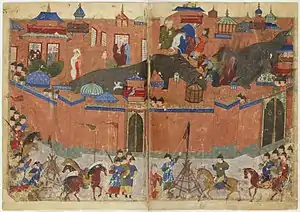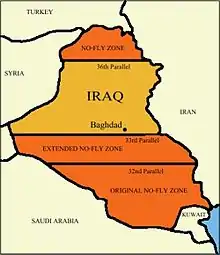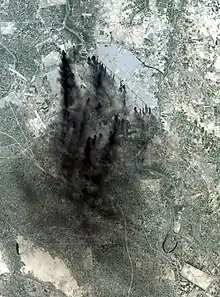Military history of Iraq
The military history of Iraq, due to a rich archaeological record, is one of the longest in written human history. The region of Iraq, which used to be Mesopotamia, has been referred to as the "cradle of civilization", and wars of conquest have been recorded in this region as far back as the third millennium BC. The area possesses strategic value, initially for the rich, fertile agricultural region in the Mesopotamian plain, and more recently for large petroleum deposits and access to the oil-rich Persian Gulf. The present territory of Iraq lacks significant strategic barriers, making it difficult to defend against foreign invasion.
Ancient times
- In 2525 BC, there was a battle between King Eannatum of Lagash, and Umma. The battle is recorded on the Stele of the Vultures. The king won the battle by using armored soldiers who were in phalanx formation, and also used chariots pulled by onagers.
- About 2300 BC, Sargon of Akkad attacked and conquered 34 Sumerian cities, beginning the Akkadian Empire.
- The Sumerians living in Iraq had to battle the Elamites from western Iran.
- Kassites attacked Babylonia in the 16th century BC
- About 1263 BC, the Assyrian king Shalmaneser I defeated a rebellion led by Shattuara II of Hanigalbat.
- Nebuchadnezzar I (1119–1098 BC) attacked Assyria.
- The Chaldeans took over Babylonia in the 9th century BC, forming the Neo-Babylonian Empire, and had to fight many revolts and aggressors.
- Nebuchadrezzar II (605-562 BC) conquered Jerusalem taking 15,000 Jewish captives, who were put into exile for 70 years. (See Babylonian captivity.)
- Cyrus the Great, founder of the Achaemenid Persian Empire, defeated the Neo-Babylonian Empire and conquered the region in 539-538 BC
- In 331 BC, Alexander the Great defeated Darius III of Persia at the Battle of Gaugamela, east of present-day Mosul. Alexander died in Babylon in 323 BC.
- In later centuries, starting from 190 BC, the Persians ruled Iraq for hundreds of years under different dynasties including the Parthian and Sassanid dynasties, after the first conquest in the 6th century BC.
- In 627 AD, the Byzantines sacked Ctesiphon, which was invaded again in 637, this time by Muslim Arabs. The battle between 18,000 Arab tribesmen led by General Khalid ibn al-Walid (The Sword of Allah) and the Persians led by Rostam Farrokhzād, was fought at the Battle of al-Qādisiyyah, south of Baghdad.
Middle Ages (634–16th century)
- Muslim Arab forces led by Khalid ibn al-Walid and Sa`d ibn Abī Waqqās conquered the area from the Sassanid Persian Empire during the Islamic conquest of Persia in the 7th century.
- In 680, Hussein bin Ali, the grandson of the Islamic prophet Muhammad, was killed in the Battle of Karbala on the day of Aashurah.
- In 701, a revolt by Ibn Ash'ath was crushed by Syrian armies.
- Around 747, a revolt led to the Abbasid caliphate being proclaimed in 750. The city of Baghdad was founded in 762 and became the center of the caliphate.
- Baghdad was sacked during the Fourth Fitna around 811.
- By 865, the Abbasid civil war (865–866) resulted in rival capitals in Samarra and Baghdad.
- In 945, the Buyid people from the Caspian Sea took over Baghdad, with the Abbasid caliphs becoming puppet rulers.
- Mosul was captured in 977.
- In 1055, the Seljuk leader Togrul Beg overran the central area of Iraq.
- The Abbasids regained control in 1135.
- Baghdad repelled an attack by the Mongols in 1245

- Baghdad was sacked on February 10, 1258, by Hulagu Khan following the Siege of Baghdad (1258), with between 250,000 and 800,000 people killed during the Mongol invasion.
- Baghdad was sacked again in 1401 by Tamerlane.
- From 1405 Turkish tribes from Anatolia took over Iraq and there was much infighting between themselves, and against local groups. The Black Sheep Turkmen at first ruled Iraq until 1466 when the White Sheep Turkmen took control.
- Around 1508, Iraq was conquered by the Safavid dynasty of Iran.
- 1533–1534 Iraq was conquered by the Ottoman Empire.
Ottoman rule (16th century–World War I)
- Baghdad was put under Persian rule between 1623 and 1638, when Murad IV restored Ottoman rule and massacred many local Shiites.
- In 1776, Basra was occupied by the Persians. They held it until 1779 when Karim Khan Zand's death precipitated a period of internal disorder and resulted in withdrawal from Basra.
British Mandate of Mesopotamia (1918–1932)
- The British invaded Iraq during World War I in the Mesopotamian Campaign. They invaded southern Mesopotamia in November 1914. The Battle of Ctesiphon was fought in November 1915. The undermanned and overstretched British forces were defeated by the Turks, who besieged the British in the city of Kut-al-Amara for 143 days in the Siege of Kut, ending with a British surrender, with 10,000 men becoming prisoners in April 1916. The British took the middle eastern campaign more seriously following this defeat, transferring command from India to the main British command, and General Frederick Stanley Maude was put in charge of British forces, leading the British to a series of victories. The battles of Mohammed Abdul Hassan, Hai and Dahra were won by the British in January 1917. In February, they recaptured Kut. On March 11, 1917, the British occupied Baghdad after the Fall of Baghdad (1917).
- Between 1920 and 1922, the British put down an Iraqi revolt costing them 40 million pounds to do so.
- In January 1921, the Royal Air Force's Mesopotamian Group was formed by raising Mesopotamian Wing to group status
- On 1 October 1922, Mesopotamian Group was absorbed into the newly formed RAF Iraq Command which was given control of all British forces in Iraq.
- Faisal I, leader of Iraq from 1921 to 1933, helped to make his country fully independent in 1932.
Post-colonial monarchy (1932–1958)
On 1 April 1941, Rashid Ali and four generals overthrew the pro-British Iraqi government. The British were concerned that the Axis powers might get involved in Iraq since the new government was pro-Axis. The British landed troops at Basra while Iraqi forces besieged RAF Habbaniya.
On 2 May, the British launched pre-emptive air strikes against Iraqi forces. On 7 May, the Iraqis abandoned the positions above RAF Habbaniya. By about 11 May, the Iraqi Air Force was neutralized. From about 13 May, the "Flyer Command Iraq" (Fliegerführer Irak) of the German Air Force (Luftwaffe) started to arrive. The aircraft of Fliegerführer Irak started to fly sorties under Iraqi colours from Mosul against the British and Commonwealth forces. For a variety of reasons, Fliegerführer Irak was able to achieve little in the way of results. British ground forces from RAF Habbaniya attacked Iraqi forces in Fallujah and, by 22 May, had withstood an Iraqi counter-attack. The British forces then attacked Baghdad, Rashid Ali and his government fled, and an armistice was signed on 31 May.
The pro-British Iraqi government was restored and the Kingdom of Iraq declared war on the Axis on 17 January 1943.
The Iraqi Army participated in the 1948 Arab–Israeli War against Israel.
Early republic (1958–1963)
The US began military aid to Iraq in 1954, and Iraq joined the pro western Baghdad Pact in 1955.
A garrison in Mosul rebelled against Qassem, and Kurdish leader Barzani returned from exile in the Soviet Union to suppress them. Iraq claimed sovereignty over Kuwait after it gained independence from Britain in 1961, but it backed down after the British sent troops to Kuwait.
Iraq sent troops and planes to Jordan during the 1967 Arab-Israeli war (the Six-Day War).
Ba'ath Party (1968–2003)
Ahmed Hassan al-Bakr (1968–1979)
Iraqi divisions fought in the 1973 October War against Israel.
Saddam Hussein (1979–2003)
Saddam Hussein came to power as President of Iraq in 1979.
Iran–Iraq War
After months of provocations and shelling of Iraqi towns and villages on the border with Iran by the newly established Ayatollah regime in Iran, Iraq responded on 22 September 1980 and achieved success in stopping the shelling of its border towns and villages. The Iran–Iraq dragged on into a long war, with between 1 and 2 million casualties. The war ended with a ceasefire on August 20, 1988 and the Iraqi military came out of it as one of the powerful military in the region.
On June 7, 1981, Israeli F-15s and F-16s bombed and destroyed the Osirak nuclear reactor, 18 miles (29 km) south of Baghdad following the orders of Israeli Prime Minister Menachem Begin.
On May 17, 1987, an Iraqi Mirage fighter fired two Exocet missiles at the American ship USS Stark (FFG-31), killing thirty-seven of the crew.
Gulf War
On August 2, 1990, Iraq invaded and annexed Kuwait. The United States led an international coalition which heavily bombed Iraq and freed Kuwait in 1991. After this war, sanctions were imposed on Iraq as well as a north and south no fly zones, and during the 1990s, Iraq was frequently bombed by American and British aircraft in small sorties.

In January 1993, the US launched a cruise missile attack against Iraq, because of it not dismantling police posts near the border with Kuwait. In June 1993, another US cruise missile attack was launched because of a suspected assassination plot against former US president George H. W. Bush. In 1996, Iraqi troops moved into northern Iraq to support the Kurdish Democratic Party against the Patriotic Union of Kurdistan. The US responded with limited air attacks in the south. There were Iraqi attacks against allied aircraft in the no fly zones in January 2001, with American and British responding with bombing of targets in northern Iraq in February.
Invasion of Iraq

The United States led a "coalition of the willing" which invaded Iraq on March 20, 2003, in a war that took three weeks to get control of the country, yet the fighting lasted much longer. Baghdad was captured on April 9. Saddam Hussein was deposed, but remained in hiding until December 14, 2003, when he was captured by the US, tried by an Iraqi court, and executed in accordance with the court's death sentence.
Interim government (2003–2008)
Iraq rebuilt its military with the aid of countries from the Coalition of the Willing (see Military of Iraq). The effort to create a new national military was complicated by focused insurgent attacks on recruitment centers and claims of insurgents' infiltration of the new forces. Saddam Hussein was executed on December 30, 2006, after a court appointed by the interim government found him guilty of ordering the deaths of the inhabitants of an Iraqi village almost 10 years earlier.